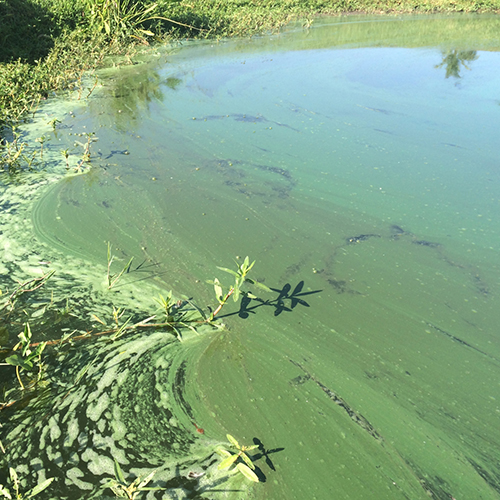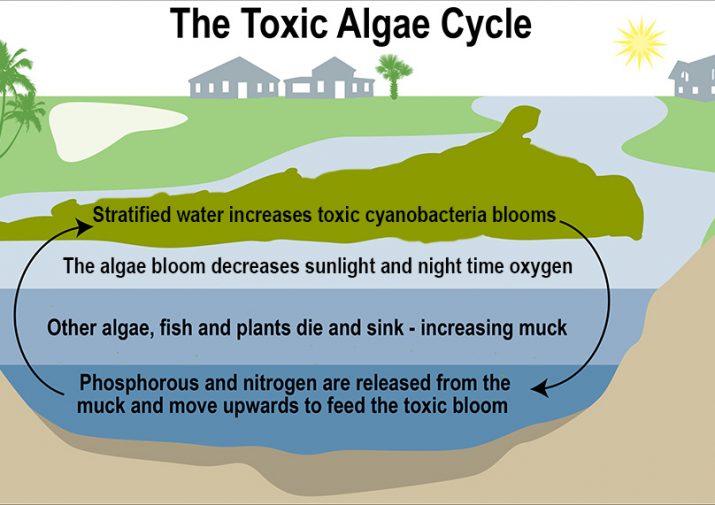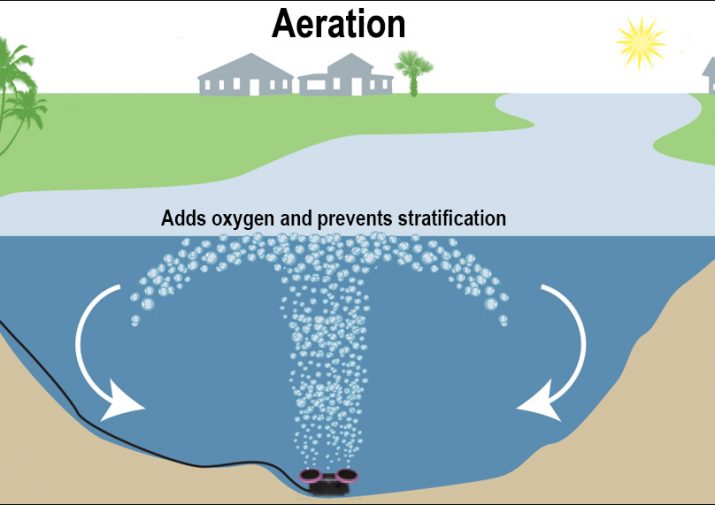Control Harmful Algae Blooms
By Patrick Goodwin, Certified Lake Manager and Aquatic Research Scientist
 Nutrient over-enrichment of waters by urban, agricultural, and industrial development has promoted the growth of cyanobacteria as harmful algae blooms (HABs). These blooms increase the turbidity of waterbodies which can smother aquatic plants and limit invertebrate and fish habitats. The die-off of blooms may deplete oxygen and kill fish. Some cyanobacteria produce toxins, which can cause serious and occasionally fatal human diseases. Harmful algae blooms threaten waterbodies around the world.
Nutrient over-enrichment of waters by urban, agricultural, and industrial development has promoted the growth of cyanobacteria as harmful algae blooms (HABs). These blooms increase the turbidity of waterbodies which can smother aquatic plants and limit invertebrate and fish habitats. The die-off of blooms may deplete oxygen and kill fish. Some cyanobacteria produce toxins, which can cause serious and occasionally fatal human diseases. Harmful algae blooms threaten waterbodies around the world.
 When lakes become stagnant and stratify, cyanobacteria can begin to proliferate causing HABs to occur. Cyanobacteria have a competitive advantage in stratified lakes. Many can move themselves up and down the water column to access light for photosynthesis. This movement allows them to out-compete other groups of algae, especially diatoms, which tend to sink more rapidly from their heavy outer shells. Breaking stratification by circulating and mixing the water “levels the playing field” for other more desirable groups of algae to become established. Mixing the water column can prevent cyanobacteria from reaching harmful bloom levels.
When lakes become stagnant and stratify, cyanobacteria can begin to proliferate causing HABs to occur. Cyanobacteria have a competitive advantage in stratified lakes. Many can move themselves up and down the water column to access light for photosynthesis. This movement allows them to out-compete other groups of algae, especially diatoms, which tend to sink more rapidly from their heavy outer shells. Breaking stratification by circulating and mixing the water “levels the playing field” for other more desirable groups of algae to become established. Mixing the water column can prevent cyanobacteria from reaching harmful bloom levels.
Adding Oxygen Reduces Algae Growth Over Time
 One commonly used lake management technique to reduce the occurrence of HABs is to pump compressed air to the bottom of a water body, in a process called aeration.
One commonly used lake management technique to reduce the occurrence of HABs is to pump compressed air to the bottom of a water body, in a process called aeration.
Aeration increases water circulation throughout the water column. The circulation prevents stratification, the layering of water due to temperature and density differences from occurring.
FIND YOUR NEAREST VERTEX DEALER
The process of circulating water also adds oxygen. Mixing water increases the contact time of atmospheric oxygen with water, allowing for increased oxygen concentrations throughout the water column. Also, oxygenation will occur from exchanges with bubbles as they rise upwards to the surface. Maintaining aerobic (oxygenated) conditions in a lake is an important mechanism to reduce HABs. Cyanobacteria prefer low oxygen environments, while green and diatom algae prefer high oxygen environments. Aeration will alter a lake’s water chemistry to become more oxidized making it less favorable for cyanobacteria to proliferate.
Control nutrients that cause harmful algae to bloom
When oxygen becomes absent at the sediment level (anaerobic), phosphorous and nitrogen are released upwards to the surface waters. These surface nutrients feed and stimulate HABs. The oxygenation process that is induced by aeration can moderate nutrients being released from lake sediments.
While aeration may seem simple on paper, the process of designing a proper aeration system that will meet your expectations and be cost-effective is often easier said than done. Under-aerating a lake can cause more problems than solve. Undersized aeration systems can bring nutrient-laden and sometimes toxic water upwards, which can further stimulate an HAB and/or cause a fish kill. At the same time, over-aerating a lake is costly, competing for funding with other restoration strategies.
Consult an aeration specialist today.
About Patrick Goodwin
 Patrick earned a Bachelor’s degree from the University of North Florida and a Master of Science in Lake Management from the University of New York, SUNY – Oneonta. As an elite NALMS Certified Lake Manager, he is a lead researcher and a recognized national authority on sustainable lake restoration technology including nutrient reduction, water quality improvement, lake aeration design and cyanobacteria management. He has been on the Florida Lake Management Society Board (FLMS) and a member since 2015. In addition, he is on the Student Committee for the Midwest Aquatic Plant Management Society (MAPMS), as well as nine other prestigious aquatic plant and lake management organizations in the country. Patrick has presented research or conducted training relating to sustainable lake management technology for multiple organizations at their annual conferences.
Patrick earned a Bachelor’s degree from the University of North Florida and a Master of Science in Lake Management from the University of New York, SUNY – Oneonta. As an elite NALMS Certified Lake Manager, he is a lead researcher and a recognized national authority on sustainable lake restoration technology including nutrient reduction, water quality improvement, lake aeration design and cyanobacteria management. He has been on the Florida Lake Management Society Board (FLMS) and a member since 2015. In addition, he is on the Student Committee for the Midwest Aquatic Plant Management Society (MAPMS), as well as nine other prestigious aquatic plant and lake management organizations in the country. Patrick has presented research or conducted training relating to sustainable lake management technology for multiple organizations at their annual conferences.
Vertex Aquatic Solutions, founded in 1977, is the professionals’ choice for research based scientific consulting services, aeration systems, floating fountains, bubble curtains and biological products to enhance water quality in lakes, ponds, canals, marinas and reservoirs. As respected leaders in the lake management industry the Vertex team of aquatic biologists, limnologists, fisheries scientists and engineers work together to deliver science-based, environmentally sound solutions to complex waterbody issues. Our products and services are delivered through an international network of qualified, experienced waterbody professionals who provide local support, service and pond management expertise to customers.
← Previous